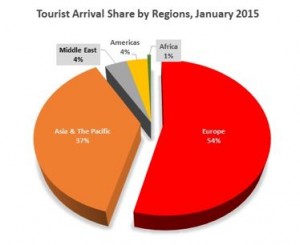Tourist arrivals reached an all-time record level for a single month with 120,468 visitors in February, the Ministry of Tourism has revealed.
Arrivals in February was 8.8 percent higher than the same period last year, which was “a significant improvement compared to the negative growth (-7.8 percent) registered in January 2015,” the tourism ministry observed in a statement on Thursday (March 19).
“With this boost, the total arrivals at end February 2015 was 217,541, an increase of +0.7 percent compared with the 216,001 tourists that visited during the same period of 2014,” the ministry noted.
The occupancy rate meanwhile declined by 4.8 percent this year, with an average occupancy rate of 80.8 percent. The average duration of stay was six days.
After falling 12.2 percent in December and 33.1 percent in January, Chinese arrivals bounced back in February with a 30.5 growth compared to February 2014.
A total of 43,349 Chinese tourists visited the Maldives last month.
At a press conference last week, Tourism Minister Ahmed Adeeb suggested that Chinese visitors increased sharply as the Chinese New Year was on February 13.
Adeeb noted that overall arrivals growth was at about one percent compared to the first two months of 2014.
“So our travel trends is not falling. The past month was a very profitable month,” he said.
However, the Maldives Inland Revenue Authority (MIRA) revealed earlier this month that revenue collection was 17.6 percent below forecasts due to “the decrease in tourism related revenues by 17 percent as tourist arrivals did not meet expectations.”
MIRA also revealed that US$2.2 million was collected last month as airport service charge, compared to US$2.3 million in February 2014.
However, Adeeb said income from Tourism Goods and Services Tax (T-GST) for February would be collected in March, and would reflect the arrivals hike.
Referring to travel alerts issued by the UK in the wake of political unrest sparked by the arrest of former President Mohamed Nasheed on February 22, Adeeb noted that tourists were only advised to avoid Malé due to demonstrations.
Asked if arrivals could decline in March due to the ongoing political crisis, Adeeb said the tourism ministry has been monitoring booking cancellations.
“Our monitoring shows there have been no booking cancelations in March,” he said, adding that he expected arrivals to remain unchanged from March 2014.
Condemning calls for tourism boycott, Adeeb said the government was countering the social media campaign by opposition supporters through marketing efforts by PR firms.
Adeeb suggested the tourism boycott campaign would not have “much of an impact.”
Regional markets
Europe retained top spot as the largest regional source market for tourist arrivals with a 49.3 percent market share in 2015.
However, with 107,263 visitors so far this year, total arrivals from Europe registered a marginal decline of 0.8 percent.
European arrivals in February declined by 1.9 percent compared to the same period last year on the back of a steep 53.4 percent decline in arrivals from Russia.
However, arrivals from the United Kingdom and Germany increased by 10.6 percent and 10.3 percent, respectively. The number of Italian tourists also grew by 10.3 percent compared to February 2014.
Total arrivals from Western Europe declined by 2.9 percent due to a fall of 15.5 percent in arrivals from France, which the tourism ministry said has been posting negative growth since July 2014.
In terms of individual markets, China remains the largest source market with a 29.3 percent market share, followed by Italy, the United Kingdom, and Germany.
Both the national carrier Maldivian Airlines and Mega Maldives launched direct weekly flights to Chinese cities during February.
The Maldives Marketing and Tourism Development Corporation (MMPRC) also conducted roadshows in three Indian cities last month to promote the Maldives as a destination for Indian tourists.
With 4,235 visitors, arrivals from India grew by 17.8 percent in February with a market share of 3.7 percent.
“During the last two months of 2015, while important markets such as Russia, and Japan registered declines of -43.9 percent and -0.6 percent respectively, significant increases were recorded from Denmark (+82.8 percent), United Arab Emirates (+47.9 percent), Brazil (+44.6 percent), Spain (+40 percent) and Romania (+33.9 percent) at the end of the period,” the ministry noted.
At the end of February, the Maldives had 308 registered establishments in operation with a bed capacity of 27,670.
“The operational capacity included 106 resorts with 23,247 beds, 15 hotels with 1,508 beds, 106 guest houses with 1,568 beds and 81 safari vessels with 1,367 beds,” the ministry revealed.
“The total tourist bed nights of these operational establishments at the end of the period was 1,313,259 which was a drop (-3.7 percent) compared with the same period of 2014.”
Related to this story
Tourist arrivals decline in January as Chinese arrivals decline
Maldives’ resorts among the best in the world, but industry insiders express concern over green tax
1.4 million figure for 2014 tourist arrivals incorrect, says tourism minister
Expansion of economic activity in third quarter driven by tourism sector: MMA
 (0)Dislikes
(0)Dislikes (0)
(0)
